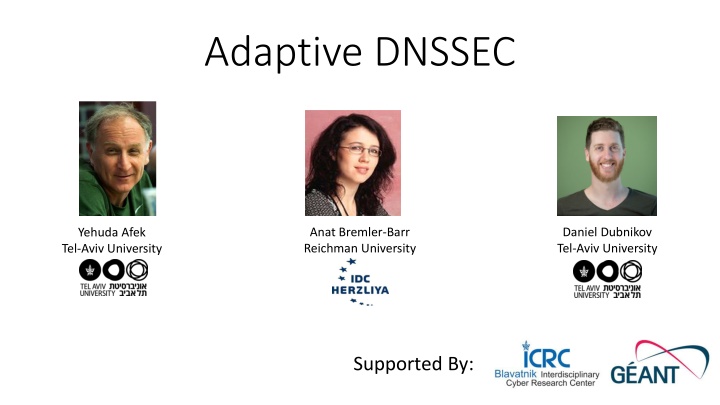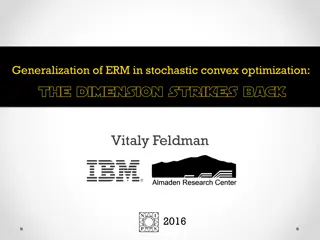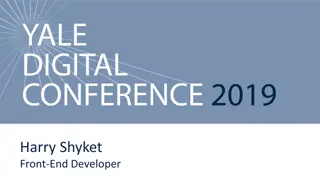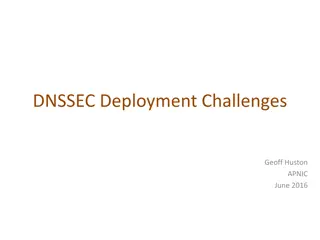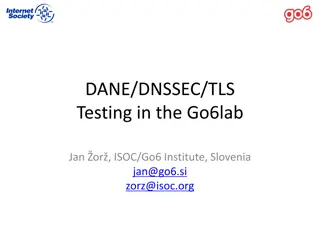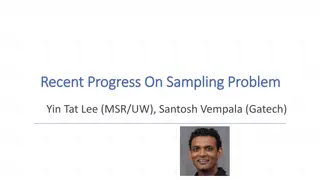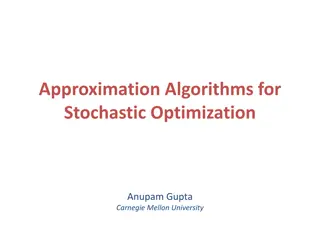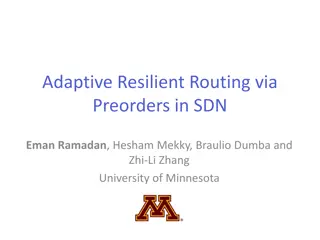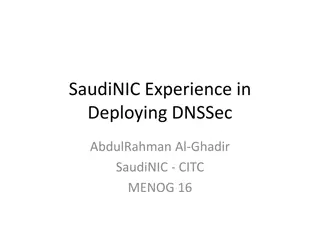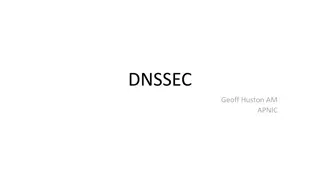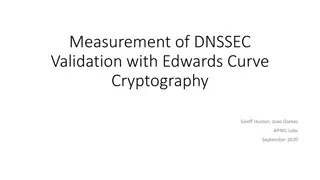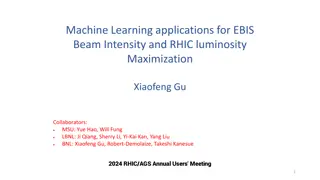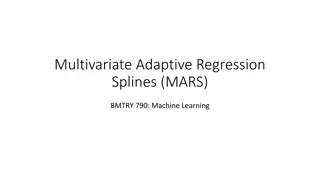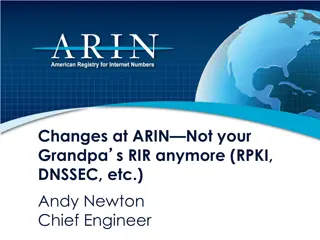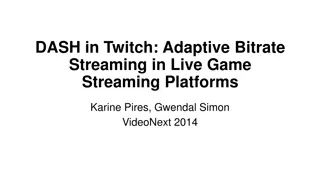Adaptive DNSSEC Performance Optimization
DNSSEC significantly impacts DNS performance, particularly under attack scenarios like NXDomain and DDoS amplification. Learn how adaptive DNSSEC strategies can address these challenges and improve overall system efficiency.
Uploaded on Mar 03, 2025 | 2 Views
Download Presentation

Please find below an Image/Link to download the presentation.
The content on the website is provided AS IS for your information and personal use only. It may not be sold, licensed, or shared on other websites without obtaining consent from the author.If you encounter any issues during the download, it is possible that the publisher has removed the file from their server.
You are allowed to download the files provided on this website for personal or commercial use, subject to the condition that they are used lawfully. All files are the property of their respective owners.
The content on the website is provided AS IS for your information and personal use only. It may not be sold, licensed, or shared on other websites without obtaining consent from the author.
E N D
Presentation Transcript
Adaptive DNSSEC Anat Bremler-Barr Reichman University Daniel Dubnikov Tel-Aviv University Yehuda Afek Tel-Aviv University Supported By:
Motivation (1) DNSSEC significantly degrades DNS performances Max Queries Per Second Plain DNS 23,524 DNSSEC: NSEC 9,510 DNSSEC: NSEC3 8,989
NXDomain NXDomain Attack RANDOM RANDOM DNS Request Flood Rxy1xhggsgVCER.sony.com XVBY$&HGDRxy2.sony.com FJH*^DHGAKRxy3.sony.com RxUYQVMNLKAy4.sony.com Resolvers www.cs.cs.tau.ac.il .com RzHW$RE43CBJs$7.sony.com ns.sony.com 3
Motivation (1) DNSSEC significantly degrades DNS performances DDoS amplification Max Queries Per Second Plain DNS 23,524 DNSSEC: NSEC 9,510 DNSSEC: NSEC3 8,989 * All measurements are under NX queries flood attack Attacker Resolver NS
Motivation (1) Non Existent in DNSSEC?
Motivation (1) Non Existent in DNSSEC? NSEC Record: ABC.NAME.COM - LMN.NAME.COM
Motivation (1) Non Existent in DNSSEC? NSEC Record: ABC.NAME.COM - LMN.NAME.COM Everything in between does not exist!
Motivation (2) Aggressive Caching (RFC 8198) stops NX Attack Max Queries Per Second Plain DNS 23,524 DNSSEC: NSEC 9,510 DNSSEC: NSEC3 8,989 Aggressive Caching Max Queries Per Second 96,226 DNSSEC: NSEC DNSSEC: NSEC3 93,756
Motivation (2) Aggressive Caching (RFC 8198) stops NX Attack Max Queries Per Second Plain DNS 23,524 DNSSEC: NSEC 9,510 DNSSEC: NSEC3 8,989 Aggressive Caching Max Queries Per Second 96,226 DNSSEC: NSEC Only Knot DNSSEC: NSEC3 93,756
Motivation (2) Aggressive Caching (RFC 8198) stops NX Attack BUT: Enables Zone Walking ABC.NAME.COM - LMN.NAME.COM Max Queries Per Second Plain DNS 23,524 DNSSEC: NSEC 9,510 DNSSEC: NSEC3 8,989 Aggressive Caching Max Queries Per Second 96,226 DNSSEC: NSEC Only Knot DNSSEC: NSEC3 93,756
Motivation (2) Aggressive Caching (RFC 8198) stops NX Attack BUT: Enables Zone Walking Scalability Issues: Need to quickly find NSEC record Max Queries Per Second Plain DNS 23,524 DNSSEC: NSEC 9,510 DNSSEC: NSEC3 8,989 Aggressive Caching Max Queries Per Second 96,226 DNSSEC: NSEC Only Knot DNSSEC: NSEC3 93,756
Motivation (2) How to stop Zone Walking?
Motivation (2) How to stop Zone Walking? You can t (without online signing*, Goldberg et al.) * Goldberg et al. Nsec5: Provably preventing dnssec zone enumeration
Motivation (2) How to stop Zone Walking? You can t (without online signing*, Goldberg et al.) Black Lies, White Lies, NSEC5 * Goldberg et al. Nsec5: Provably preventing dnssec zone enumeration
Motivation (2) How to stop Zone Walking? You can t (without online signing*, Goldberg et al.) Black Lies, White Lies, NSEC5 NX.NAME.COM - NX.NAME.COM * Goldberg et al. Nsec5: Provably preventing dnssec zone enumeration
Motivation (2) How to stop Zone Walking? You can t (without online signing*, Goldberg et al.) Black Lies, White Lies, NSEC5 Must sign the record on the fly NX.NAME.COM - NX.NAME.COM * Goldberg et al. Nsec5: Provably preventing dnssec zone enumeration
Motivation (3) Online Signing Algorithms NX Attacks Amplified Max Queries Per Second % of Plain DNS Plain DNS 23,524 100% DNSSEC: NSEC 9,510 40% DNSSEC: NSEC3 8,989 38% DNSSEC: White Lies 5,863 25% DNSSEC: Black Lies 7,206 30% DNSSEC: NSEC5 6,324 27%
Motivation (3) Online Signing Algorithms NX Attacks Amplified For security and scalability reasons online signing might be the only option Max Queries Per Second % of Plain DNS Plain DNS 23,524 100% DNSSEC: NSEC 9,510 40% DNSSEC: NSEC3 8,989 38% DNSSEC: White Lies 5,863 25% DNSSEC: Black Lies 7,206 30% DNSSEC: NSEC5 6,324 27%
DNSSEC Increase packet size Increase response count Add CPU load -> DoS Amplification NSEC/3 Aggressive Caching Zone Walking Scalability (for CDNs) Disposable Domains W/B Lies + NSEC5
Proposed Solution Remove all DNSSEC overheads Packet Size + Count CPU Load
Proposed Solution Remove all DNSSEC overheads Packet Size + Count CPU Load Use TLS Authoritative identifies once Traffic sent with Plain DNS
Proposed Solution - Hybrid High Traffic DNS over Secure TLS Authoritative Nameserver Resolver Low Traffic DNSSEC over UDP
Proposed Solution PoC (1) Problem1: Can t easily integrate with known resolver/auth implementations (Bind, Unbound, Knot, etc.) Solution: proxy interface resolver - authoritative servers Resolver Machine Authoritative Machine
Proposed Solution PoC (2) Problem2: TLS overheads are high TLS suffers from Head-of-Line blocking
Proposed Solution PoC (2) Problem2: TLS overheads are high TLS suffers from Head-of-Line blocking Solution: Use QUIC (similar to HTTP3) UDP Multiplexing (virtual connections) 0-RTT: resume the connection with 0 round trip time No need for TCP integration (firewalls/IPS)
Proposed Solution PoC (3) Problem3: Teardown and restart QUIC connections
Proposed Solution PoC (3) Problem3: Teardown and restart QUIC connections Solution: Keep connections alive QUIC has low overhead long lived connections QUIC can resume quickly
Proposed Solution PoC (4) Problem4: Resource limit
Proposed Solution PoC (4) Problem4: Resource limit Solution: Score connection throughput with ??= ? ?? 1+ 1 ? ?? Terminate lowest scored connection (LRU)
Measurements Knot Max Queries Per Second % of Plain DNS Plain DNS 23,524 100% DNSSEC: NSEC 9,510 40% DNSSEC: NSEC3 8,989 38% DNSSEC: White Lies 5,863 25% DNSSEC: Black Lies 7,206 30% DNSSEC: NSEC5 6,324 27%
Measurements With QUIC, using the same experiment (NX flood), throughput is 87% of the plain DNS Knot Max Queries Per Second % of Plain DNS Plain DNS 23,524 100% DNSSEC: NSEC 9,510 40% DNSSEC: NSEC3 8,989 38% DNSSEC: White Lies 5,863 25% DNSSEC: Black Lies 7,206 30% DNSSEC: NSEC5 6,324 27% AdaDoQ (Our Solution) 20,558 87%
Conclusions DNSSEC degrades DNS performance Make NXDOMAIN attacks worse (DDoS amplification) AdaDoQ Hybrid Solution Light and fast connections One time encryption overheads Close to Plain DNS throughput No Security Compromises Zone Walking No Scalability Issues
Questions? Questions?
